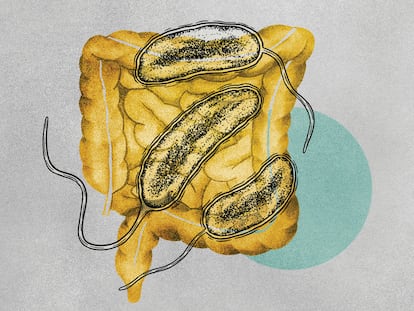The Medellín neighborhood that’s building its own action plan for climate change
El Pacífico — in Comuna 8, one of the city’s 16 districts — is working on a risk management plan to mitigate the effects of climate change. This neighborhood movement is trying to understand how global warming affects residents and how they can adapt to it
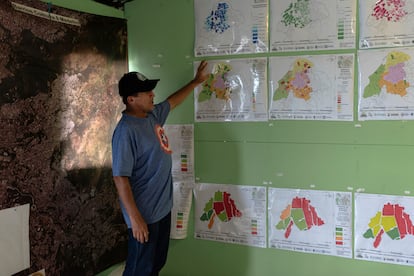

On the narrow roads that cross the Pacífico neighborhood in Comuna 8 — one of Medellín’s 16 districts — there are steps painted yellow. On some walls, there are arrows — also painted yellow — that point to where people should head, in the event of a catastrophe.
The neighborhood is located in a hillside area, almost at the top of the city’s northeastern mountain — you can walk around easily after taking a Metrocable to get up there. There are three major risks here: torrential flooding, earthquakes and landslides. “And for each of these scenarios, we have an evacuation route,” says James Rúa, a local leader and member of the community action board.
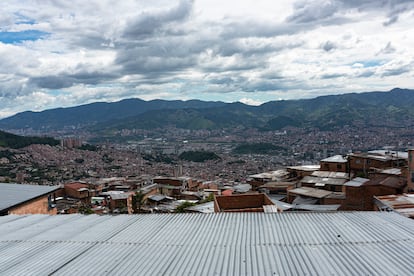
The history of Pacífico — like some of the neighboring boroughs — is linked to violence. Many people migrated there in the early 1990s from the rural provinces of Antioquia. Others — like Dairo Urán, president of the board — arrived after they were pushed out of their homes because of the high prices. “[Medellin] displaced me because I no longer had a way to pay rent. [When we arrived], the neighborhood was just boards and plastic.”
Things have changed. There are now concrete houses and even a sewer, thanks to pressure that the residents exerted through the Medellín Hillside Movement. This is also one of the few neighborhoods that has a risk management plan. Not only are the residents aware that they’re vulnerable: they’ve been proactive in adapting and crafting strategies to reduce risk throughout the neighborhood. At the local council’s headquarters, for example, they have a series of maps that indicate the risk level according to each sector and what specific issues the people who live there feel most insecure about. These maps also identify who lives in each house, or if vulnerable people — such as the elderly — inhabit the residences. This information makes it possible to know where everyone is if something happens. Everything is prepared.
This risk management plan, moreover, is becoming increasingly sophisticated. Thanks to a grant that the neighborhood won from the Ministry of Science and the support of Pascual Bravo University, community leaders have been able to carry out more rigorous monitoring of their surroundings. One major risk is La Rafita — a ravine that, in September of 2020, expanded as a result of torrential flooding. “The water came with so much force… it hit the side here and created waves. You felt like you could have gone surfings,” sighs Urán, pointing to a house whose structure was washed away by the water.

Due to that experience, last month, the entire community built a retaining wall in the same high-risk area. Everything was done on a volunteer basis — something which, they hope, is temporary. “Ideally and logically, the Medellín [municipal] administration would be the one to do these things and put up a more secure wall for us,” explains Urán. However, nobody has much faith. So far, all major emergency preparations in the neighborhood have been taken by residents. “From the community,” the leaders repeat.
Now that the water level in La Rafita is lower, they monitor it in two ways. Through the Early Warning System of Medellín and the Aburrá Valley (SIATA), which offers insight regarding what the rains will be like. Urán explains that “human monitoring” is the other method. “After it rains, one of the leaders comes and checks the ravine, sees if large rocks have moved and makes a photographic report — he sends it to a WhatsApp group that we have.” If they decide that an alert is necessary, the community of about 1,600 people is informed. They’re told to “stay inside their houses, but at the door. And they should have a kit with their documents ready, in case something happens to the house while they evacuate; nothing important should be left inside.”
A panel of neighborhood experts
Standing in front of the risk maps, Dairo Urán mentions what has become an issue at the forefront of everyone’s mind: “Now comes the climate change crisis.” But he also adds something that few people are saying: “And for that, we’re also getting prepared.” The Medellín Hillside Movement has joined with the IPCC: the Inter-neighborhood Panel on Climate Change, an educational cause reminiscent of another IPCC — the Intergovernmental Panel on Climate Change — which brings together more than 200 scientists, who review the latest evidence that exists about this phenomenon worldwide.
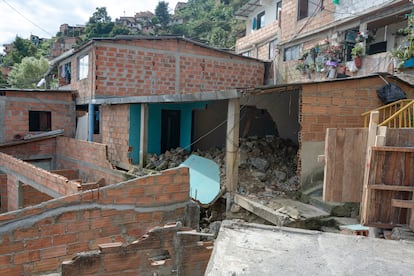
“The first thing we did with the [inter-neighborhood] IPCC was to collect the reports made by the [intergovernmental] IPCC. We asked ourselves: what does a 1.5°C [temperature increase] mean in my neighborhood?” says Hendys Paola Guzmán Tenjo, a member of the Laderas Movement of Medellín. The IPCC has done a couple of things to address this. One has to do with circulating knowledge about climate change, so that members of the community are aware. In some of the cases, for example, community leaders began to put layers of clothing and blankets on residents, to exemplify how greenhouse gases are increasing the temperature of the earth. On another occasion, they invited Colombian scientist Paola Arias — one of the authors of the latest global IPCC report — to give a talk.
The second course of action is to provide different levels of understanding, as the intergovernmental IPCC does. “Within each [part of the district] — on the upper, middle and lower slopes — there’s different territorial knowledge,” Guzmán adds. The inter-neighborhood IPCC can provide new data, not only about how climate change impacts them, but how to adapt to it. In fact, it was the Ladera Movement that asked the Medellín municipal government to declare a climate emergency: this was finally done in November of 2022.
The IPCC is part of something bigger: it emerges from one of the four “popular schools” that have been set up by community leaders. Two are about food and water security, one is about energy and the last one is about climate actions. These bring together people from across the district.
With the energy school in the Pacífico neighborhood, the volunteer instructors are fine-tuning a water turbine prototype, to provide electricity in the headquarters of the Community Action Board. Currently, it’s a motorcycle wheel (without the rim), with kitchen ladles glued around it. Water collected from the rains and from La Rafita makes it spin. This movement is converted into energy which, in turn, becomes light. But Urán explains that they’re working to make the turbine from a lighter material, so as to improve the process.
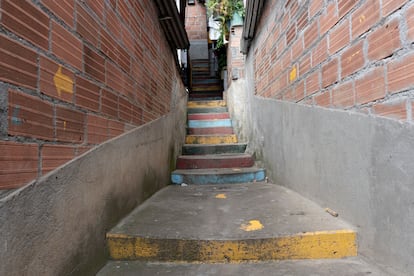
Guzmán emphasizes that the point of all this work is to stop seeing nature as an enemy and to instead see it as an ally. The water from La Rafita — which previously swept away five houses — is also the source that will give them light. It’s simply a matter of adapting. “They [falsely] taught us that the fight is with the mountain or the ravine,” says Guzmán, at an event in the Colombian capital of Bogotá, where they’re presenting what their inter-neighborhood network is all about. “[The authorities] said that we were taking a chance by going to live there, on the hillside, as if one simply chooses where they want to live. That’s why, today, we have to get rid of the discourse that says that nature is a threat.”
Sign up for our weekly newsletter to get more English-language news coverage from EL PAÍS USA Edition
Tu suscripción se está usando en otro dispositivo
¿Quieres añadir otro usuario a tu suscripción?
Si continúas leyendo en este dispositivo, no se podrá leer en el otro.
FlechaTu suscripción se está usando en otro dispositivo y solo puedes acceder a EL PAÍS desde un dispositivo a la vez.
Si quieres compartir tu cuenta, cambia tu suscripción a la modalidad Premium, así podrás añadir otro usuario. Cada uno accederá con su propia cuenta de email, lo que os permitirá personalizar vuestra experiencia en EL PAÍS.
¿Tienes una suscripción de empresa? Accede aquí para contratar más cuentas.
En el caso de no saber quién está usando tu cuenta, te recomendamos cambiar tu contraseña aquí.
Si decides continuar compartiendo tu cuenta, este mensaje se mostrará en tu dispositivo y en el de la otra persona que está usando tu cuenta de forma indefinida, afectando a tu experiencia de lectura. Puedes consultar aquí los términos y condiciones de la suscripción digital.
More information
Archived In
Últimas noticias
Most viewed
- Reinhard Genzel, Nobel laureate in physics: ‘One-minute videos will never give you the truth’
- Oona Chaplin: ‘I told James Cameron that I was living in a treehouse and starting a permaculture project with a friend’
- Pablo Escobar’s hippos: A serious environmental problem, 40 years on
- Chevy Chase, the beloved comedian who was a monster off camera: ‘Not everyone hated him, just the people who’ve worked with him’
- Why we lost the habit of sleeping in two segments and how that changed our sense of time

